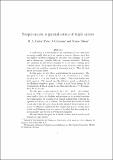Files in this item
Sesqui-arrays, a generalisation of triple arrays
Item metadata
| dc.contributor.author | Bailey, Rosemary Anne | |
| dc.contributor.author | Cameron, Peter Jephson | |
| dc.contributor.author | Nilson, Tomas | |
| dc.date.accessioned | 2018-02-15T11:30:07Z | |
| dc.date.available | 2018-02-15T11:30:07Z | |
| dc.date.issued | 2018-06-01 | |
| dc.identifier | 252286083 | |
| dc.identifier | 84630260-9625-4962-9759-3e3aeff2e23b | |
| dc.identifier | 85046829751 | |
| dc.identifier | 000431776200008 | |
| dc.identifier.citation | Bailey , R A , Cameron , P J & Nilson , T 2018 , ' Sesqui-arrays, a generalisation of triple arrays ' , Australasian Journal of Combinatorics , vol. 71 , no. 3 , pp. 427-451 . < http://ajc.maths.uq.edu.au/pdf/71/ajc_v71_p427.pdf > | en |
| dc.identifier.issn | 2202-3518 | |
| dc.identifier.other | ORCID: /0000-0002-8990-2099/work/44629840 | |
| dc.identifier.other | ORCID: /0000-0003-3130-9505/work/58055606 | |
| dc.identifier.uri | https://hdl.handle.net/10023/12725 | |
| dc.description.abstract | A triple array is a rectangular array containing letters, each letter occurring equally often with no repeats in rows or columns, such that the number of letters common to two rows, two columns, or a row and a column are (possibly different) non-zero constants. Deleting the condition on the letters commonto a row and a column gives a double array. We propose the term sesqui-array for such an array when only the condition on pairs ofcolumns is deleted. Thus all triple arrays are sesqui-arrays.In this paper we give three constructions for sesqui-arrays. The first gives (n+1) x n2 arrays on n(n+1) letters for n>1. (Such an array for n=2 was found by Bagchi.) This construction uses Latin squares.The second uses the Sylvester graph, a subgraph of the Hoffman--Singleton graph, to build a good block design for 36 treatments in 42 blocks of size 6, and then uses this in a 7 x 36 sesqui-array for 42 letters. We also give a construction for K x (K-1)(K-2)/2 sesqui-arrays onK(K-1)/2 letters. This construction uses biplanes. It starts with a block of a biplane and produces an array which satisfies the requirements for a sesqui-array except possibly that of having no repeated letters in a row or column. We show that this condition holds if and only if the Hussain chains for the selected block contain no 4-cycles. A sufficient condition for the construction to give a triple array is that each Hussain chain is a union of 3-cycles; but this condition is not necessary, and we give a few further examples. We also discuss the question of which of these arrays provide good designs for experiments. | |
| dc.format.extent | 302134 | |
| dc.language.iso | eng | |
| dc.relation.ispartof | Australasian Journal of Combinatorics | en |
| dc.subject | QA Mathematics | en |
| dc.subject | T-NDAS | en |
| dc.subject.lcc | QA | en |
| dc.title | Sesqui-arrays, a generalisation of triple arrays | en |
| dc.type | Journal article | en |
| dc.contributor.institution | University of St Andrews. Pure Mathematics | en |
| dc.contributor.institution | University of St Andrews. Centre for Interdisciplinary Research in Computational Algebra | en |
| dc.contributor.institution | University of St Andrews. Statistics | en |
| dc.description.status | Peer reviewed | en |
| dc.identifier.url | http://ajc.maths.uq.edu.au/pdf/71/ajc_v71_p427.pdf | en |
This item appears in the following Collection(s)
Items in the St Andrews Research Repository are protected by copyright, with all rights reserved, unless otherwise indicated.

